#Bluey glasshouse school
Text
Bluey’s School (Glasshouse School) (1/?)
Bluey’s school is quite interesting; aspects of it will be covered in a few posts because there’s a lot to talk about.
We’ll start with a topic we’ve previously mentioned in this Tumblr: location.

Unlike conventional elementary schools for young children, the specialized school Bluey attends (more on this in a future post) is not close by to Bluey’s home. It doesn’t seem to be near any of Bluey’s classmates homes either: it is located in a rural area, and doesn’t appear to have transit service. (Australia doesn’t have dedicated yellow school buses like in North America, but transit agencies do set up children-only dedicated routes when it is practical.)
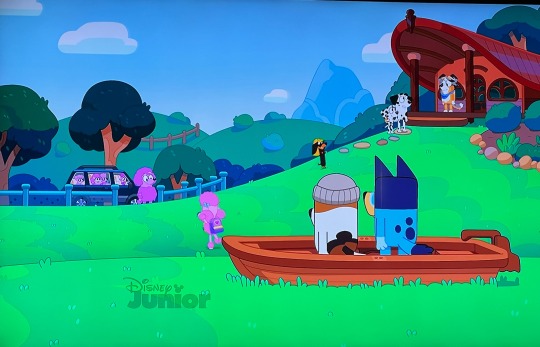
The small size and rural location of the school Bluey and her friends attend means everyone has to be driven to it.

The whole “it’s in a rural location” was in fact noteworthy enough that the episode “Explorers” focussed on it being comically hard to get to for parents unfamiliar with the location.

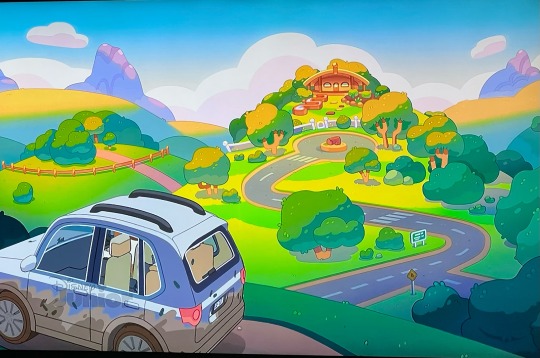
A school like this where everyone must be shuttled in from all across Brisbane must create a challenge for parents; it must impact the parents’ other travel during the day / be factored into their schedules.

It looks like there are a few occasional carpoolers (like Rusty and Jack, noted in “Cricket”) but it’s not a location that can easily implement a shuttle bus or logically be considered for service by public transit. Funding a dedicated service (even with a minibus) would add significantly to any costs associated with an education at this school.
Not that the rural location is totally a downside; there is plenty of undeveloped space for playing and exploring. Indeed, the lack of playground equipment is deliberate; we’ll get into that in a future post.

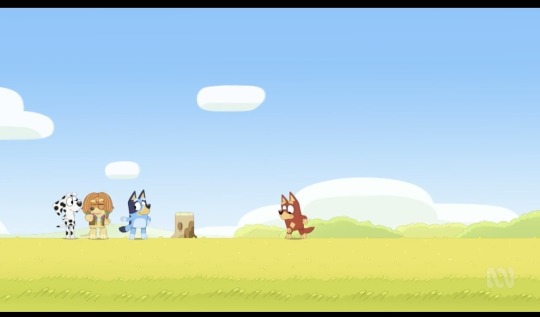

One last comment for this post, based on my own experience: a school with students spread throughout a city means that most of the time if Bluey wants to visit a friend, a transit or car trip is almost inevitable; she can’t just walk or ride a bike. This must be a considered a downside compared to if everyone was in close proximity to one another.
56 notes
·
View notes
Text
Round 1, Bracket 7

9 notes
·
View notes
Text
My Bluey OC
Name
Whitney Ward.
Gender
Female.
Breed
Komondor.
Appearance
Whitney is a tall, chubby Komondor puppy with great natural strength, brown eyes, and soft, pure white fur grown out long and matted into her breed’s iconic dense dreadlocks. She wears decorative gold rings on the ones on her head and a black cord necklace with a red chewable bone-shaped pendant. Being autistic and nonverbal, she communicates through sounds, body language and typing and clicking pictures on an AAC app on her tablet, which has a red case; she can take time to find the right words, both in her head and on her tablet’s system. She may also wear red noise-cancelling headphones to cope with her hypersensitive hearing.
Age
Seven.
Backstory
Her mother Opal holds a senior position in a sewage treatment plant. Her father Sugar is a speech therapist who’s worked part-time primarily online from home since Whitney was born. They’re both deeply loving and do their best to provide her with a safe, comfortable physical and emotional environment that she can thrive in. The family uses a lot of shorthands to help Whitney get her points across easier.
For the last year and a half, she was in the special needs class of a local normal school. She was insufficiently accommodated, bullied and unfairly blamed by teachers there. When her parents realized what was going on, they were horrified and transferred her to Glasshouse Primary School. She’s doing much better there and has made new friends in Calypso’s class. Sugar and Opal are debating moving in the future to be closer to the school and its other students’ neighbourhood, but don’t want the massive change to distress Whitney, guilty about letting her suffer so much already.
Personality
Whitney is patient, observant, thoughtful and careful. She’s had to learn to be, with her developmental delays in speech and to an extent mental processing and reading usually making her take longer to do things than her peers. At her old school, she was left out and behind a lot and got used to entertaining herself. She’s analytically, strategically intelligent, but doesn’t do well academically. She has a strong sense of justice and believes that doing a bad thing always deserves punishment, struggling to apply this concept with nuance and in degrees. She prefers to wait, think carefully and try to look at the bigger picture and disapproves of others acting rashly. But once she’s sure she’s assessed a situation correctly, she will be very confident, stubborn and even self-righteous in her course of action.
She likes rules and is highly organized and dutiful. She genuinely doesn’t understand mischief, how getting in trouble or annoying adults, outside of mild teasing in contexts known to be completely safe like her family dynamic, could be fun. It certainly wasn’t at her old school, and she wasn’t even doing it on purpose. She spends most of her time and energy just trying to do things right. She has an instinctive respect for and trust in authority figures and institutions. After all, people wouldn’t be in charge for bad reasons, would they? That would mean that the whole system worked badly! And that would be stupid. This is part of why it took so long for her parents to figure out that her old school was one such bad system - Whitney assumed her teachers were right about her deserving her treatment and didn’t want to complain, on top of communication being practically difficult. Now she’s slowly building up her sense of unconditional self-worth and beginning to understand that adults can be downright wrong and cruel.
Her special interests are the Caprinae subfamily of sheep and goats, water supply systems and the properties and care of all different types of dog fur, inspired by wool and the Komondor breed’s often remarked-upon unique fur. She loves to watch herds of sheep and a fluffy toy Suffolk sheep called Cotton is her comfort object. The textures of wool and many other types of hair are extremely pleasant to her. She loves to play hairdresser, sheepdog, security guard and army. She stims by fiddling with her hair and even hides her face in her cords when anxious or upset. She’s also in the habit of lightly flicking and slapping people with them, either playfully as a physical form of teasing or to make them leave her alone or respect her personal space, especially if she’s stressed. She’s starting to pick up a hobby of photography too, taking pictures with her tablet.
She’s very protective of her friends, afraid of losing them after finally getting them, and possessions, and concern for them is basically the only thing besides fear and pain that can make her be impulsive and careless. She doesn’t like sharing her things. As words can be hard for her, she prefers to express her care through actions. Her good friends are Honey, Jack, Rusty and Mackenzie. She likes Bluey, Snickers and Coco, but their energy can be overwhelming and hard to keep up with sometimes.
Other Notes
She likes to playfight with her parents and friends. She’s occasionally too rough and is working on identifying cues that the other person isn’t having fun anymore.
She has a restricted diet and strong sensitivity to mouthfeel. She mainly eats rice, bread, pasta, noodles, meat and seafood, dislikes spice and sourness and has vitamins more than vegetables. She likes chewy foods and her favourite foods are beef jerky and Choo Choo Bars, as chewing is one of her stims (she used to chew her dreadlocks before getting her necklace). Sugar, befitting his name, loves sweet flavours and eats more confectionery than her.
One Ward family shorthand is “sewage treatment” or ST for a difficult, even downright unpleasant, but necessary and ultimately beneficial task, based on Opal explaining her work and its importance to Whitney. The parents doing housework? ST. Whitney learning a hard new word on her AAC app that will help her express herself better? ST. Her meeting neurotypical social norms like eye contact or not stimming or using sensory accommodations? Not ST. If there’s no good reason behind it, if it doesn’t help anybody, if it’s painful or too uncomfortable or draining to worth Whitney’s while, it is just sewage. That means it needs to be avoided for the sake of her health. Her parents are strong advocates of every child being taught and enabled to recognize the difference between ST and sewage types of demands made of them, particularly those who are communication-impaired and therefore easy to bully and take advantage of.
Her interschool buddy in Mia and Captain’s class is a twelve-year-old Yorkshire Terrier girl named Claire. Claire is kind, generous, extroverted, optimistic, fearless and talkative. She’s used to her small size not always being accommodated for, and has even been teased for it, so she’s fiercely protective of her little buddy (who happens to be physically bigger than her). Whitney likes to listen to her talk and stroke her silky fur.
Red is her favourite colour. As she grows older and more mature, she takes to wearing the fur cords on her head up in a ponytail in a red scrunchie.
#bluey oc#my oc#bluey#komondors are really cool so i had to honour them#real ones don’t have their cords when they’re puppies#their outer coat grows out to make them possible to form over their first two years#but in bluey dogs have human lifespans#so she still got the cords at about two#and gets to be a mop puppy!
5 notes
·
View notes
Text
Bluey’s School (Glasshouse School) (2/?)
References in this post are primarily from this link: https://academics.hamilton.edu/government/dparis/govt375/spring97/Teacher_Training/tt4.html
Waldorf Schools
Any episode that includes Bluey’s school… right away you can tell that it is an atypical school. It is: it’s a Waldorf school. The teaching style, curriculum, etc. are all distinct from standard approaches.
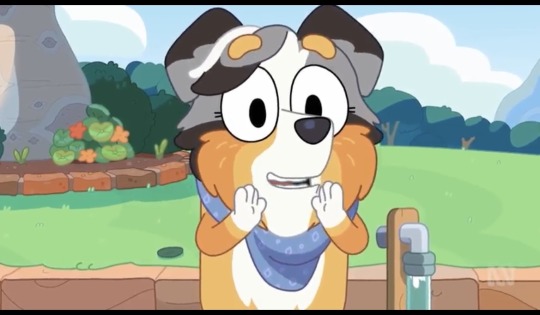
Here’s a deep dive on this based on some online research…
Rudolf Steiner, the founder of the first Waldorf school in Germany in 1919, believed that all children should be given "individualized" attention (rather than just those with special needs.)
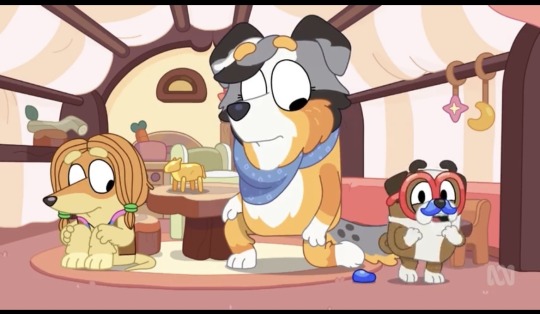
This style of education emphasizes a focus on the 'individual' rather than the 'group', with each child being valued for their individual accomplishments: every child is deserving of the same attention typically given to gifted and learning-disabled students in conventional educational streams.

Classes within these schools are structured in a unique system of "blocks" that focus on particular areas of study for a period of three to four weeks rather than the same subjects for the whole school year or semester.
As children grow older, more concrete and technical areas of subjects are introduced. Through this method, not only are the developing child's needs met, but so are their interests. As a result, students are kept actively engaged.
Features of this style of education
Key elements of the Waldorf educational approach include:
Teachers try to fully engage the individual student at each step by gearing the curriculum to their age and needs.
Teachers focus on the child's learning processes and achievements in all areas, not just the academic. In this way, the children can be developed as complete human beings.
Waldorf classrooms don't include computers, televisions, etc. Note how in “Typewriter”, Bluey thinks she needs a typewriter for a story but her teacher takes the focus off of typing a story and onto Bluey and her friends actually having an adventure.

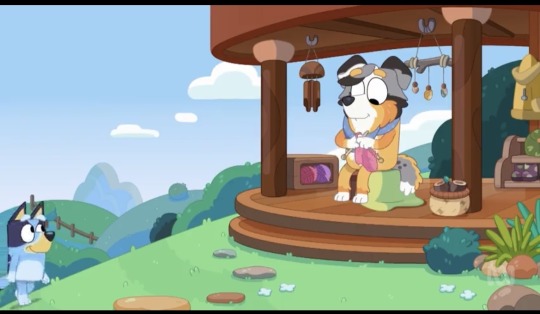
The Waldorf curriculum integrates arts and music into all areas of study. Daily activities include drawing, painting, singing, instrument playing…
Even the aesthetic atmosphere of the classroom is different to a standard school: The Tampa Tribune described a Waldorf school setting: "Imagine a classroom with old wooden tables, a backyard garden and children learning to knit and crochet. Where art and music is intertwined with every subject, students write their own textbooks and the toys are all handmade". Which is definitely the look/feel in Bluey’s school…

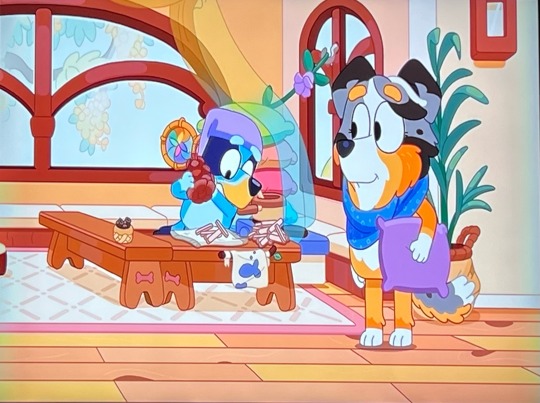
Additionally, a tenet of this style of education is that a focus on art and nature in education can lead to a greater appreciation for the beauty of life later on.
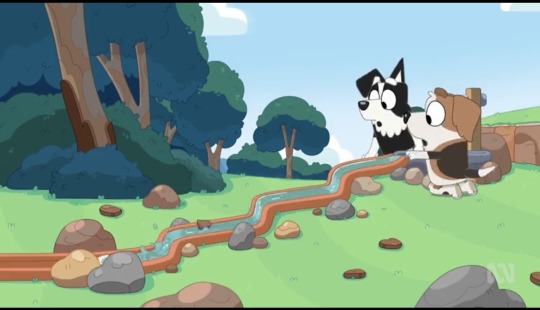
Waldorf schools encourage children to keep working on their imagination skills beyond kindergarten, using these skills to learn how to co-operate, share and interact. This concept of letting children progress into adulthood at their own level is a unique cornerstone of the Waldorf education method.

This concept of letting children progress into adulthood at their own level is a unique cornerstone of the Waldorf education method. This last piece is very key -- we seldom see anything being taught to the children; they’re free to do their own thing, make up activities, interact with one another, problem-solve, etc. and Calypso is there to gently guide them towards solutions occasionally.
So Why is This in “Bluey”?
The show “Bluey” is somewhat based on the show’s creator, Joe Brumm’s life experiences as a parent. Joe Brumm chose to have his daughter educated this way after she started the first grade. This is explained by Joe Brumm in an interview with the website The Father Hood:
"Bluey was still in embryonic form when Brumm’s eldest daughter started school. Her experience changed the course of the show.
'Play time was suddenly taken away from her, it was just yanked and seeing the difference in her was horrendous,' he says. 'There was no playing, there was no drawing, it was just straight into all this academic stuff. And the light in her eyes just died.'
Brumm researched alternatives for schooling and researched the value of play for child development. It is said that this is what led him to select Waldorf-style education for his daughter.
'Bluey is just one long extrapolation of that,' Brumm says. 'It’s to encourage people to look at play not just as kids mucking around, but as a really critical stage in their development that, I think, we overlook at their peril.'
Quotes from Joe Brumm from this link:
Closing comment & a caution
Personally, I think it’s interesting to see a different approach of educating children depicted in a TV show. It’s not “oddball”, it’s just a part of these dog-children’s lives.
I feel like the public is exposed to a lot of examples of children’s education on television and it’s generally portrayed in a negative light: e.g. The Simpsons, Bob’s Burgers… and even on shows like “Arthur” the kids were often complaining about school, or having something unpleasant/stressful take place while at school.
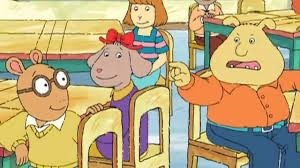
My only concern for Bluey and her classmates (and maybe it’s a long-term issue, nothing to worry about in the short term) is this: a potential downside to a Waldorf-style education would potentially be the sharp adjustment a student will encounter transitioning from this nurturing environment to one where that isn’t the case. It could well be unsettling.
…phew, ok, maybe one or two more posts about the school to come.
(Maybe, because of the source material, some of this post may sound a little like a giant sales pitch… it’s not meant to be. I think it’s interesting because it’s different; something else to learn about, etc.)
68 notes
·
View notes
Text
Bluey’s School (Glasshouse School) (3/?)
Criticisms of the Waldorf educational approach
As mentioned in the last post on this, the Waldorf educational style emphasizes:
A slow build towards academic topics, spending more time on imagination and relationships in early grades;
A low-tech nature-oriented approach; and
An “everybody is important” mindset.
Advocates say that this approach can help children’s creativity, support motivation for learning, and remove/defer societal pressures on children. However, there are also detractors/critics.
Below, a few of the criticisms of the Waldorf (also sometimes called Steiner) educational approach.
Deferred Academics
So as we pointed out in the last post, the Waldorf approach to education seeks to protect children from the pressures of the outside world.
Consistent with this philosophy, many Waldorf schools don’t teach traditional ‘basic skills’ in literacy and numeracy until students are older.

(Note how in “Relax”, Bluey didn’t know numbers when she asked Mum which button to press in the elevator.)
Up until about age 7, most learning occurs through storytelling, drawing, and oral communication. There is greater emphasis on social skills, creativity, arts, and practical sciences. This fosters an appreciation of these topics in children as they mature.
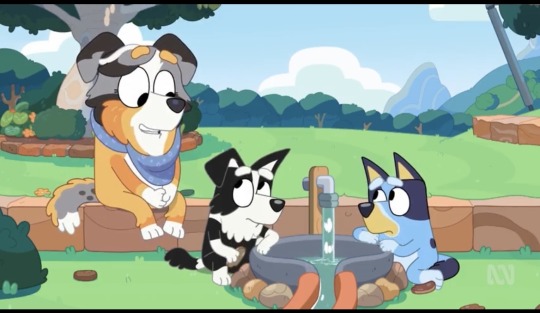
On one hand that sounds good — academics and a drive to perform can be tough on children at any age. But there are many parents who also want to make sure their their children are not at a disadvantage. If a child misses out on the first few years of learning, potentially a student could fall behind and find it impossible to catch up?
Fortunately, many studies of the success rates and exam results of Steiner/Waldorf taught children demonstrate that this is not the case; Waldorf students ultimately perform academically as well, if not better, than non-Waldorf students despite a later start on academic subjects.
No Tech
The Steiner/Waldorf approach to teaching focuses on natural environments with a strong focus on beauty and a natural aesthetic, hence wooden furniture, simple wooden toys, etc.
No computers, no tablets, no TVs.
Does this put children in these schools at a disadvantage? These days, middle-class western children are using tablet computers from a young age, and they’re very much a part of “regular” schools.
As technology becomes more and more integral the gap between Waldorf schools and technology-heavy STEM/STEAM programs in mainstream schools might be viewed negatively.

Note that in “Bluey”, Bluey and Bingo appear to have their screen time (tablet and TV) limited/restricted. And there are subtle hints that TV time is discouraged and to be kept to a minimum. Whereas Muffin and Socks may be getting more screen time at their house.


This may not be a problem if students are exposed to age-appropriate levels/quantities of technology outside of school, the way Bluey and Bingo are.
One Teacher For 5 To 8 Years(!)
Teachers tend to stay with students for multiple years in Waldorf schools. A student potentially can have the same teacher for five to eight years.
There are pros and cons to this approach.
Students theoretically are able to develop deep relationships with their teacher which could give them more comfort and a greater sense of familiarity/security. Almost an additional parent figure?

However, teacher turnover can also be a positive thing. Individual teachers have their strengths and weaknesses.
Also, it can be a good thing for a student to experience a range of different teachers and adult influences to gain a breadth of experiences of different teaching personas. Such as a male teacher vs. a female one. New teachers bring fresh perspectives.
If a child doesn’t gel with their teacher, they could be encumbered with them for up to eight years.
Waldorf Schools Are Expensive
Generally speaking, Waldorf schools are private. Because of this, they are often too expensive for working-class or low-income families. $10,000 AUD for a year’s tuition is not unheard of, although these costs vary from one grade to another and from school to school.
Not everyone in Bluey’s friend group are in the same economic group; some are well-to-do, like Chloe (and Honey, I’d assume) and some less so based on their homes. Maybe some of the families have access to grants?

27 notes
·
View notes
Text
School of All Time Qualifiers
Royal Academy from Ascendance of a Bookworm
Wu’s Academy from Lego Ninjago
Glasshouse Primary School from Bluey
Starlight Academy from Aikatsu
Clyde Nite’s Night Knight School from The Adventure Zone: Graduation
The top two schools will advance to the bracket rounds. The third place winner could possibly advance as well if it gets a large enough number of votes.
#ascendance of a bookworm#lego ninjago#bluey#aikatsu#the adventure zone graduation#polls#tumblr polls#bracket tournament
7 notes
·
View notes